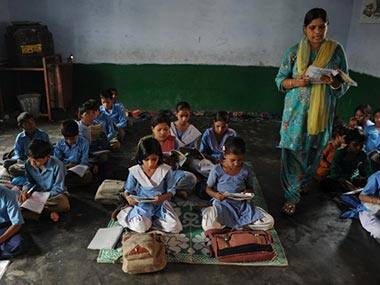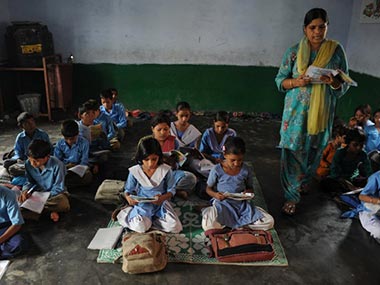The latest ASER survey conducted by the Pratham Education Foundation of rural schools across India offers some startling results. For starters, 96 percent of kids between 6 to 14 years are enrolled in a school. Hurray, right? Except this: 53.2 percent of children in Std V cannot read a Std II level text, up from 46 percent in 2010. The number for government schools is more abysmal: up from 49.3 percent (2010) to 58.3 percent (2012). This: 61.3 percent of children in Std III cannot read a Std I level text, up from 53.4 percent in 2009. For children enrolled in government schools, this figure has increased from 57.6 percent to 67.7 percent in 2012. And this: Fifth Standard kids who could not solve simple two-digit subtraction problems increased from 29.1 percent in 2010 to 46.5 percent in 2012. We have more kids than ever in school, and ever more of them are practically illiterate. Cue the wailing about the abysmal state of government schools. But the more interesting story lies elsewhere, in this little statistic from the survey: “Since 2009, private school enrollment in rural areas has been rising at an annual rate of about 10 percent. If this trend continues, by 2018 India will have 50 percent children in rural areas enrolled in private schools.” In an accompanying article, Pratham CEO Madhav Chavan, writes:
We have believed for a long time -and this is the logic of RTE- that governments will provide or provide for education of a large majority of children. This premise is likely not to be valid ten years from now… Private school enrollment in rural India is increasing at about 10 percent every year or about 3 percentage points per year. In the election year of 2014, about 41 percent of all of India’s primary age children will be in private schools, and by the time 2019 elections come around, private sector will be the clear major formal education provider in India.
The rural trends represent a nation-wide acceleration of what has long been an urban trend, where up to 55 percent of kids attend private schools, recognised and unrecognised. Rich or poor, everyone wants their kid to go to a private school. And yet this is what HRD minister Pallam Raju said at the release of the ASER survey: “We have been spending a lot of money on improving the reach of schools. All these are interventions. We are not unduly alarmed by parents sending their children to private schools, want to focus on improving standards in government schools.” [caption id=“attachment_598817” align=“alignleft” width=“380”]  A file photo of school children read in a classroom at a government school in Bagpath district in Uttar Pradesh. AFP[/caption] Refusing to read the writing on the wall, the government continues to plough ever greater amounts of money into state-run schools that are failing their students — and disdained by their parents. The New York Times in 2011 reported:
In Mumbai, so many parents have pulled their children out of government schools that officials have started renting empty classrooms to charities and labor unions — and even to private schools. In recent years, Indian officials have increased spending on government education, dedicating far more money for new schools, hiring teachers and providing free lunches to students. Still, more and more parents are choosing to go private.
Then HRD minister Sibal bragged to the Times that the Right to Education Act is putting aside $2 billion for states “to improve facilities, hire new teachers and improve curriculum” in government schools. Now, private schools aren’t perfect, and they are not immune to the plummeting levels of literacy. As Pratham’s Chavan notes:
However, the contrast between government and private school performance is easily visible in every state and can be seen in the state pages of this report. It should be stated again that private school education is not great and socio-economic-educational background of children’s families, parental aspirations and additional support for learning contribute majorly to their better performance. Yet, fact remains that the learning gap between government and private school children is widening. This widening gap may make the private schools look better, but in an absolute sense it is important to note that less than 40% of Std 5 children in private schools could solve a simple division sum in 2012.
Yet the countless private schools — many of them unrecognised with poor facilities, sanitation, and standards — are still preferable to low income Indians living in slums. A parent whose children go to a small unrecognised school in East Delhi, told _Firstpost_ : “It is not a question of how much the fees is. We want a good education for our children. The main thing is discipline, which is absent in government schools. Teachers themselves are missing in government schools… Our children’s future is unsafe in a government school. Not only is it far away, I feel no one is serious about education there.” But if ASER’s results are right, no one is serious about education anywhere. Poor Indians are just making the best of very bad choices, except for one difference: In private schools they are paying for the privilege, a high price for a modest difference in learning. The UPA government’s cure — as — has been worse than the disease: to shut down scores of unrecognised schools under the RTE act without making any provision for the displaced children. Unable or unwilling to improve government schools, they have cut the only avenue — however narrow — to an education. And all this because our government is not willing to accept a simple truth: no one wants to send their child to a government school. “What does it say about the quality of your product that you can’t even give it away for free?” asks Professor Karthik Muralidharan in the New York Times. What indeed!


)
)
)
)
)
)
)
)
)



